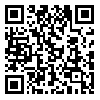BibTeX | RIS | EndNote | Medlars | ProCite | Reference Manager | RefWorks
Send citation to:
URL: http://rehabilitationj.uswr.ac.ir/article-1-1736-en.html
2- Department of Children with Special Needs, Faculty of Psychologic and Education Science, University of Isfahan, Isfahan, Iran., Associate Professor of the Department of Children with Special Needs, University of Isfahan, Isfahan. Iran.
3- Department of Children with Special Needs, Faculty of Psychologic and Education Science, University of Isfahan, Isfahan, Iran., MA student of Psychology of Children with Special Needs. University of Isfahan. Isfahan. Iran
4- Department of Consulting, Faculty of Psychologic and Education Science, University of Isfahan, Isfahan, Iran., MA student of Counseling. University of Isfahan. Isfahan. Iran.
Objective Joint attention refers to person’s ability in focusing on the present information in his or her visual attention, along with existing information on other’s visual attention. In this process, 2 people actively pay attention to a thing, situation, or event. Defects in joint attention is considered one of the first diagnosable signs in children with autism spectrum disorder (ASD). This skill has considerable effect on growth and development of social, cognitive, and verbal skills. In other words, joint attention may act as a key skill, i.e. achieving this area of growth, brings several by-products for children. Therefore, using therapeutic early interventions in order to improve the joint attention of children with ASD is necessary. The present study aimed to investigate the effectiveness of family-based early intervention on the improvement of joint attention of the children with ASD.
Materials & Methods The research population included 57 children who had referred to Ordibehesht Autism Center in Isfahan. Because the present research sought for special cases, the purposeful sampling method was used. In this regard, the research sample comprised 3 children of 3-5 years old who had symptoms of autism spectrum disorder by the diagnosis of specialists, and had difficulties regarding joint attention. The research instrument was the Gilliam Autism Rating Scale (GARS) and Early Social Communication Scales (ESCS). In the present study, the single-subject study with the A-B design was used. In this method, after 5 baseline sessions, intervention was started and during 12 individual sessions, the joint attention skill is taught to children. To analyze the obtained data, at first the raw data were converted to standard T scores and the situation of baseline, intervention, and follow up of every subject was drawn on the diagram. To interpret and infer from the diagrams, we used visual analyses, trending, and stability, as well as percentages of non-overlapping data and overlapping data.
Results According to the visual analyses of the data diagrams, the intervention was effective on the 3 subjects. The mean scores of 3 subjects in the baseline have increased from 39.92, 37.30, and 38.89 to 52.04, 52.79, and 51.69, respectively. The percentage of non-overlapping data (PND) in the two baseline
and intervention situations for the 3 subjects was 83%, 100%, and 91%. This effectiveness was observable in the follow-up stage.
Conclusion The findings of the present study indicated that the family-based early intervention can be an effective educational program for improvement of joint attention of the preschool children with ASD. Because defects in joint attention is one of the main features of children with ASD and joint attention brings improvement in other aspects of growth, we suggest that improving joint attention be considered as a main objective in rehabilitation and educational interventions in children with autism.
Received: 27/08/2015 | Accepted: 18/09/2015 | Published: 1/04/2016
| Rights and permissions | |
 |
This work is licensed under a Creative Commons Attribution-NonCommercial 4.0 International License. |






